Contributed By
Published
If Panzer Dragoon was only ever inspired by one story, this would be it. Nausicaä is a science fiction universe that is overflowing with themes found in Panzer Dragoon.
A special thanks to Lance Way for some of the ideas used in this article. All screenshots in this article were taken from the Nausicaä of the Valley of the Wind anime, however the text primarily refers to the manga.
Contents
- Introduction
- The Seven Days of Fire
- The Sea of Corruption
- Princess Nausicaä
- Nausicaä’s Mehve
- The Torumekian Empire
- The Giant Insects
- Other Similarities
- The Crypt of Shuwa
Introduction
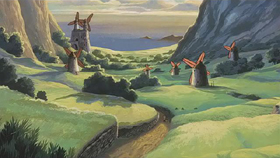
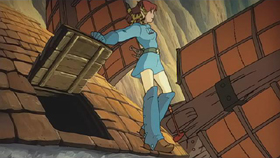
There are at least a handful of stories that could be likened to Panzer Dragoon, but among these none share so many similarities to the series as does Hayao Miyazaki’s series of graphic novels, Nausicaä of the Valley of the Wind. Miyazaki took thirteen years to complete his epic from start to finish; the end result is a lengthy saga that tells the story of a young princess called Nausicaä who has grown up in a world torn apart by warring nations and the poisonous forest (the Sea of Corruption) left behind by an ancient technologically advanced civilisation that disappeared one thousand years ago in an event known only as ‘the Seven Days of Fire’. Sound familiar? Nausicaä of the Valley of the Wind shares many of the same characteristics as Panzer Dragoon, not just its story, but the whole concept of the post apocalyptic fantasy/science fiction world, from the gigantic warships, to the hordes of flying monsters, right down to the two legged horseclaws that the inhabitants of Nausicaä’s world use as a means of transportation. In fact, I would go as far as to say that Team Andromeda was almost certainly inspired by Miyazaki’s work (Nausicaä was written before the original Panzer Dragoon game was released). As you will see by reading the points below, the parallels are all too apparent to ignore.
The Seven Days of Fire
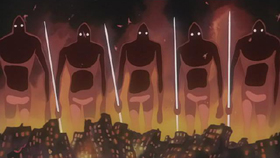
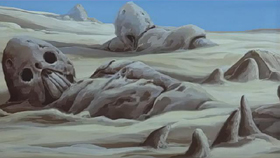
The story of Nausicaä of the Valley of the Wind begins with its prologue: a brief paragraph that sums up the catastrophic end of an industrial civilisation that existed at the peak of humanity’s civilisation, approximately one thousand years before the story takes place. Much like the Panzer Dragoon world, we know little about this ancient civilisation (at least, at the start of the story) apart from the obvious - it was incredibly advanced, and consisted of large factories that produced giant ships that could travel to the stars. Its technology was infinitely superior and was considered miraculous by many of the people living in the present day world. However, technology became the undoing of humanity. At some point near the end of this once prosperous civilisation, monstrous creatures bioengineered by the people known as God Warriors (the “dragons” of Nausicaä) destroyed most of the world in the Seven Days of Fire, leaving little but a wasteland and the remaining humans struggling to survive as a poisonous forest began to consume the Earth. As with the Ancient Age in the Panzer Dragoon series, the Ceramic Era of Nausicaä’s world came to an abrupt end.
The Sea of Corruption
The Sea of Corruption is the main threat of the modern day world in Nausicaä. To put it simply, the Sea of Corruption is a giant forest that began slowly increasing across the face of the planet after the Seven Days of Fire. From the polluted wastelands of the old world, the forest had emerged, created by the people of the past. Humans live in settlements near the borders of the forest, but seldom dare to venture into it, as the plants produce poisonous miasma and great deadly insects roam amongst the giant fungi.
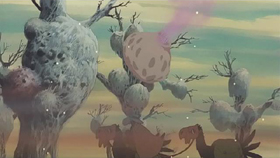
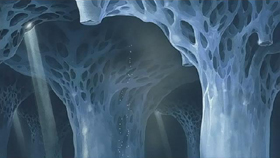
One could quite easily draw parallels between the Sea of Corruption and the Towers in Panzer Dragoon. The Towers were both a curse and a way of life to the residents of the Panzer Dragoon world. On the one hand they bred biomonsters, and destroyed the Ancient civilisation, but on the other hand, could the people of the Panzer world survive without the Towers? Panzer Dragoon Orta proves that yes, they could, but with much difficulty; over half the population of the Continent died due to the deactivation of the Towers. Similarly, the Sea of Corruption is essential to the environment’s stability, while at the same time it keeps humanity on the brink of extinction. Yet deep within the forest new plants grow that are unpolluted, almost as if the forest was trying to restore the world to an untainted state. Some say that the Sea of Corruption was God’s punishment for Man polluting the world, a theme that also carries over into Panzer Dragoon.
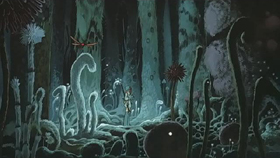
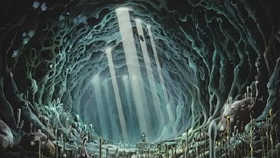
Much like the Towers of Panzer Dragoon, the true purpose of the forest’s creation is shrouded in mystery until the end of the story, but one thing is made quite clear: the forest has much more control of the world than humans do - and perhaps ever will.
Princess Nausicaä
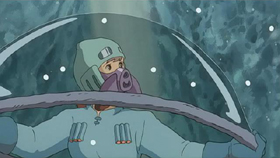
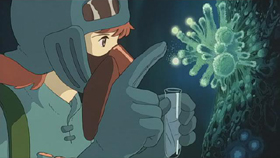
Unlike the Panzer Dragoon series, Nausicaä of the Valley of the Wind features a main human character who is the centre piece of all the books in the series. Nausicaä is the only surviving daughter of King Jhil of the Valley of the Wind, a small kingdom on the edge of the frontier. As Jhil slowly nears his death due to the poisonous miasma given off by the Sea of Corruption, Nausicaä is faced with the duty of leading the people of the Valley of the Wind through the struggles ahead. Nausicaä is a brave and compassionate girl who at the beginning of the tale fights with her heart rather than her head. However as the story continues, Nausicaä’s wisdom grows and she becomes a heroine who will do anything within her power to stop the warring nations from destroying themselves and all of the diminishing natural resources left on the planet. Ultimately, Nausicaä tries to do whatever she can to stop the seemingly endless death and destruction all around her, not just of human beings, but the destruction of all living things.
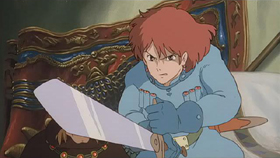
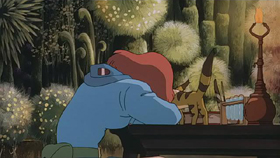
Some might say that Nausicaä parallels the latest Panzer Dragoon heroine, Orta, but I would disagree. Although both characters are somewhat important (Nausicaä is a princess, and Orta apparently has the power to change the world), to me it seems that Lundi reflects Nausicaä’s personality much more than Orta does. Both characters are brought up in small settlements on the borders of great warring empires, share a unique bond with nature and the bio engineered creatures around them, and carry a strong compassion for both humans and animals alike. Like Lundi’s empathic bond with the dragon Lagi, Nausicaä shared a bond with the giant insects known as ‘Ohmu’ that lived in the Sea of Corruption. While most humans viewed the Ohmu as nothing more than crazed monsters, Nausicaä learnt to understand the Ohmu’s emotions and their importance to the ecological balance of her world. At one stage in the story, Nausicaä even risks her life to save a baby Ohmu from the Doroks, a deed that reminded me greatly of when Lundi refused to put Lagi to death.
Nausicaä’s Mehve
Most transportation in Eurasia (the continent where Nausicaä of the Valley of the Wind takes place) is done via large airships that travel the skies. However, although Nausicaä rides in one of these airships at more than one stage of the story, she also travels the skies using another means of transportation: her Mehve. While it isn’t a living creature, Nausicaä’s Mehve can be compared to the dragon that Kyle, Lundi, Edge, and Orta ride in the Panzer Dragoon games. Although obviously different in appearance, both are crucial aids to the main character in his or her quest.
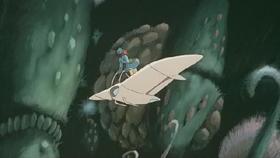
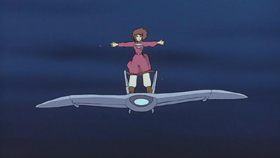
Also, both the dragon and the Mehve are seen as divine figures in the eyes of some. The Doroks prophesied that an angel of light would come from the sky, riding upon a white bird through the wind and clad in blue, a description that they later assigned to Nausicaä as she flew to their aid on her Mehve. Likewise, the dragon in Panzer Dragoon Saga was viewed by the people of Zoah as a messenger of the gods.
The Torumekian Empire
From the ashes of the old world, one nation rose above the others through the power and efficiency of military might. Torumeka is a vast empire to the east of the Valley of the Wind, and plays a crucial part in Nausicaä’s story. Near the beginning of the story, the Emperor of the Torumekian Empire declares war on its neighbours, the Dorok Principalities, forcing Nausicaä to choose between siding with those who were supposed to be her allies and waging war on the Doroks with them, or refusing to fight and making enemies of both sides.
Much like the Empire in Panzer Dragoon, the Torumekian Empire is both the current technological might of the world and the home of a large proportion of its population. The Torumekian Empire also has a rather large armada of airships, which it uses throughout the story to wage war upon other nations.
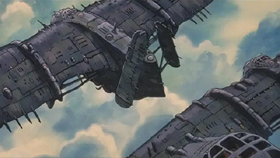
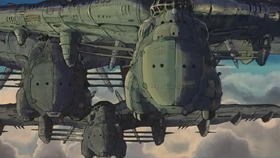
The two empires do have a number of differences, however. Unlike the Empire of Panzer Dragoon, which often only acts as a slight hindrance to the dragon riders of the story, the Torumekian Empire plays a crucial role in how a number of events come into motion, and on more than one occasion does Nausicaä directly accompany them. The Torumekian Empire also houses some interesting characters that have much more depth than any emperor of ‘the Empire’. The Torumekian Emperor’s daughter, Princess Kushana (pictured below) in particular, carries more similarities to Craymen than any Imperial commander (not that we’ve been introduced to many). The two military leaders both travel down similar paths in many ways, both being strong individuals who were loved by those under their command not because of their position, but how they chose to fight for what they believed was the greater good. The way each character’s story ends is far from the same, however.
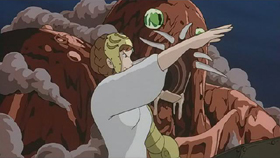
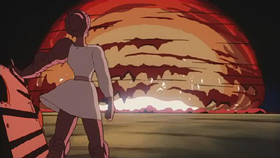
The Giant Insects
The Sea of Corruption is not only a dangerous place because of the poisonous plants that inhabit it. Insects also have adapted to the forest’s environment, which humans have learned to fear. Like the monsters in the Panzer Dragoon series, the giant insects of Nausicaä of the Valley of the Wind, come in a variety of species. There are the smaller wasp-like insects, which resemble the Nanyds from the Garil Desert. These insects travel in swarms and, although not very deadly on their own to an airship, the sheer number of them can easily overwhelm even the most heavily armoured battleship.
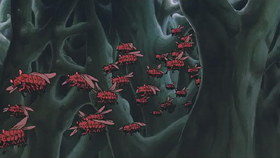
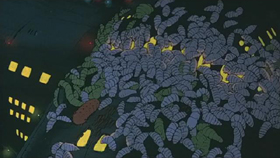
There are also larger insects such as the ohmu mentioned earlier. The ohmu are in many ways similar to the desert worms in Panzer Dragoon Saga. Although they can be just as aggressive as other insects, the Ohmu’s part to play in the story parallels the giant desert worms because they are both more than just huge monsters that have to be destroyed. In fact, both stories show the creatures helping the protagonist. When Edge destroys the lathum and saves a baby worm, the other worms open passages that help him travel through the desert. For Nausicaä, the ohmu save her life, after she saved one of their kind. The theme here seems to be that humans can coexist in an altered environment, and with the creatures inhabiting it, if they try hard enough to understand it.
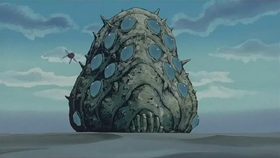
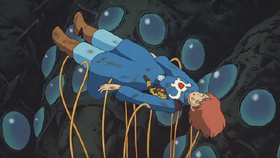
It’s also worth noting that the desert worms share a physical likeness in some ways to the ohmu. Both feature large eyes, plated armour, and have wire-like feelers surrounding/coming out of their mouths.
Other Similarities
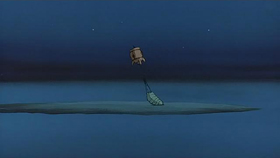
The parallels don’t end here. There are so many other similarities between Nausicaä and Panzer Dragoon, that you couldn’t count them on both your fingers and your toes. Both worlds have excavation sites scattered throughout their worlds - the nation of Pejitei, for example, unearthed an item of great importance from one of these and were soon after attacked by the Torumekian Empire, much like how Craymen ruthlessly attacked Excavation Site #4 when he was searching for Azel. The Forest People, a secret organisation who live deep in the heart of the Sea of Corruption can be paralleled to Panzer Dragoon’s Seekers. The wormhandlers, thought of as ‘disgusting savages’ by the Torumekian Empire can be compared to the wormriders as both factions don’t seem to have a problem mixing with the monsters of their respective worlds. We can also compare the many traits of the Dorok Principalities to the Empire of Panzer Dragoon. Both nations, driven by the desperate need to survive in a war torn world, unearthed ancient powers that would have been better left untouched.
If you haven’t done so already, and you’re a Panzer Dragoon fan, all I can say is: read the manga. You’ll be surprised at the number of similarities found between Nausicaä of the Valley of the Wind and Panzer Dragoon, although, of course, both stories are very different at the same time.
The Crypt of Shuwa
Warning: If you haven’t read Nausicaä yet, I would strongly advise that you stop reading now, as the rest of this article contains major spoilers regarding the manga’s ending.
As you will know if you’ve finished reading Nausicaä of the Valley of the Wind, the ending is one part of the story that is a dead give away to some of the more sinister secrets of the Panzer Dragoon world. Near the end of the story, Nausicaä travels to the Crypt of Shuwa, a strange structure from before the Seven Days of Fire. Although I said before that the Sea of Corruption parallels the Towers, the Crypt also resembles a Tower, but mainly in appearance. Both structures are huge, near indestructible slabs of ancient technology that end up being the main element of possession in which all of the major players in the story are fighting over. Inside the crypt, she encounters the Master of the Crypt. Although the true identity of the Master of the Crypt is never fully explained, we know that he and the other ghostly souls inside the crypt, are what remains of the ancient people of the old world.
In order to purify an overpopulated and ruinous world, the Sea of Corruption was created. Unlike any natural forest, the Sea of Corruption was created with a goal in mind - to destroy the old world and everything that remained that could be a threat to the new, ‘purified’ world that the forest was creating to replace it. Unfortunately, this new world that the ancients had prepared did not account for the current race of humans who had survived the Seven Days of Fire as their bodies had been modified to adapt to the miasma. They now could no longer live without the poison just as much as they could not live without clean air.
In Panzer Dragoon, things are a little different, but the basic idea is the same: the Ancients went into hibernation as their world was about to be destroyed and deliberately planned to return once their artificial creations had healed the wounds of the planet to a state fit for their survival. The Master of the Crypt promised Nausicaä a paradise where she could be restored to an original body. The Ancients of the Panzer Dragoon world were portrayed similarly, in a round about way, through the books of Zoah that were written about them:
The Gods shall return and again watch the world. They will bring glory and happiness to all. It is a day without an end, and the paradise promised to us.
Ultimately, however, Nausicaä refused to listen to the Master of the Crypt as she knew that his words were full of deceit: there was no place for the people of her world in this new idealistic world. The Master of the Crypt believed that the human race would eventually become swallowed up by the Sea of Corruption and extinct if the world was not restored to its former state, but Nausicaä simply replied, “Extinction has long since become a part of our lives.” Whether her choice was right is open for debate.
The Crypt of Shuwa and the Master of the Crypt can be compared to Sestren the place and Sestren the being respectively. Both Sestren and the Master of the Crypt were specifically created to manipulate and control the human race still living on the planet, although they did so in different ways. When Edge encountered Sestren he refused to listen to the words of Sestren, the embodiment of the will of the Ancients, and consequently freed the world from enslavement, but at the terrible cost of losing half of the continent’s population during the Great Fall. Panzer Dragoon Orta confirms that, as in Nausicaä’s world, the Ancients were planning to be brought back, but Abadd failed to find a means of reviving them. Whether that was because Edge deactivated the Towers is something that has not been revealed in the Panzer Dragoon storyline.
